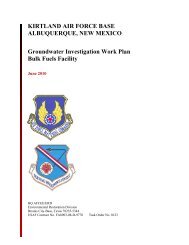Final FONSI and EA for hot cargo pad on Kirtland AFB - Kirtland Air ...
Final FONSI and EA for hot cargo pad on Kirtland AFB - Kirtland Air ...
Final FONSI and EA for hot cargo pad on Kirtland AFB - Kirtland Air ...
Create successful ePaper yourself
Turn your PDF publications into a flip-book with our unique Google optimized e-Paper software.
Safety<br />
AFI 91-202, USAF Mishap Preventi<strong>on</strong> Program, implements <strong>Air</strong> Force Policy Directive (AFPD) 91-2,<br />
Safety Programs. It establishes mishap preventi<strong>on</strong> program requirements (including the Bird/Wildlife<br />
<strong>Air</strong>craft Strike Hazard [BASH] Program), assigns resp<strong>on</strong>sibilities <str<strong>on</strong>g>for</str<strong>on</strong>g> program elements, <str<strong>on</strong>g>and</str<strong>on</strong>g> c<strong>on</strong>tains<br />
program management in<str<strong>on</strong>g>for</str<strong>on</strong>g>mati<strong>on</strong>. This instructi<strong>on</strong> applies to all USAF pers<strong>on</strong>nel.<br />
AFI 91-301, <strong>Air</strong> Force Occupati<strong>on</strong>al <str<strong>on</strong>g>and</str<strong>on</strong>g> Envir<strong>on</strong>mental Safety, Fire Protecti<strong>on</strong>, <str<strong>on</strong>g>and</str<strong>on</strong>g> Health (AFOSH)<br />
Program, implements AFPD 91-3, Occupati<strong>on</strong>al Safety <str<strong>on</strong>g>and</str<strong>on</strong>g> Health, by outlining the AFOSH Program.<br />
The purpose of the AFOSH Program is to minimize loss of USAF resources <str<strong>on</strong>g>and</str<strong>on</strong>g> to protect USAF<br />
pers<strong>on</strong>nel from occupati<strong>on</strong>al deaths, injuries, or illnesses by managing risks. In c<strong>on</strong>juncti<strong>on</strong> with the<br />
USAF Mishap Preventi<strong>on</strong> Program, these st<str<strong>on</strong>g>and</str<strong>on</strong>g>ards ensure all USAF workplaces meet Federal safety <str<strong>on</strong>g>and</str<strong>on</strong>g><br />
health requirements. This instructi<strong>on</strong> applies to all USAF activities.<br />
Geological Resources<br />
Recognizing that milli<strong>on</strong>s of acres per year of prime farml<str<strong>on</strong>g>and</str<strong>on</strong>g> are lost to development, C<strong>on</strong>gress passed<br />
the Farml<str<strong>on</strong>g>and</str<strong>on</strong>g> Protecti<strong>on</strong> Policy Act to minimize the extent to which Federal programs c<strong>on</strong>tribute to the<br />
unnecessary <str<strong>on</strong>g>and</str<strong>on</strong>g> irreversible c<strong>on</strong>versi<strong>on</strong> of farml<str<strong>on</strong>g>and</str<strong>on</strong>g> (7 CFR Part 658). Prime farml<str<strong>on</strong>g>and</str<strong>on</strong>g> are soils that<br />
have a combinati<strong>on</strong> of soil <str<strong>on</strong>g>and</str<strong>on</strong>g> l<str<strong>on</strong>g>and</str<strong>on</strong>g>scape properties that make them highly suitable <str<strong>on</strong>g>for</str<strong>on</strong>g> cropl<str<strong>on</strong>g>and</str<strong>on</strong>g>, such as<br />
high inherent fertility, good water-holding capacity, deep or thick effective rooting z<strong>on</strong>es, <str<strong>on</strong>g>and</str<strong>on</strong>g> are not<br />
subject to periodic flooding. Under the Farml<str<strong>on</strong>g>and</str<strong>on</strong>g> Protecti<strong>on</strong> Policy Act, agencies are encouraged to<br />
c<strong>on</strong>serve prime or unique farml<str<strong>on</strong>g>and</str<strong>on</strong>g>s when alternatives are practicable. Some activities that are not subject<br />
to the Farml<str<strong>on</strong>g>and</str<strong>on</strong>g> Protecti<strong>on</strong> Policy Act include Federal permitting <str<strong>on</strong>g>and</str<strong>on</strong>g> licensing, projects <strong>on</strong> l<str<strong>on</strong>g>and</str<strong>on</strong>g> already<br />
in urban development or used <str<strong>on</strong>g>for</str<strong>on</strong>g> water storage, c<strong>on</strong>structi<strong>on</strong> <str<strong>on</strong>g>for</str<strong>on</strong>g> nati<strong>on</strong>al defense purposes, or<br />
c<strong>on</strong>structi<strong>on</strong> of new minor sec<strong>on</strong>dary structures such as a garage or storage shed.<br />
Water Resources<br />
The Clean Water Act (CWA) of 1977 is an amendment to the Federal Water Polluti<strong>on</strong> C<strong>on</strong>trol Act of<br />
1972, is administered by USEPA, <str<strong>on</strong>g>and</str<strong>on</strong>g> sets the basic structure <str<strong>on</strong>g>for</str<strong>on</strong>g> regulating discharges of pollutants into<br />
U.S. waters. The CWA requires USEPA to establish water quality st<str<strong>on</strong>g>and</str<strong>on</strong>g>ards <str<strong>on</strong>g>for</str<strong>on</strong>g> specified c<strong>on</strong>taminants<br />
in surface waters <str<strong>on</strong>g>and</str<strong>on</strong>g> <str<strong>on</strong>g>for</str<strong>on</strong>g>bids the discharge of pollutants from a point source into navigable waters without<br />
a Nati<strong>on</strong>al Pollutant Discharge Eliminati<strong>on</strong> System (NPDES) permit. NPDES permits are issued by<br />
USEPA or the appropriate state if it has assumed resp<strong>on</strong>sibility. Secti<strong>on</strong> 404 of the CWA establishes a<br />
Federal program to regulate the discharge of dredge <str<strong>on</strong>g>and</str<strong>on</strong>g> fill material into waters of the United States.<br />
Secti<strong>on</strong> 404 permits are issued by the U.S. Army Corps of Engineers (USACE). Waters of the United<br />
States include interstate <str<strong>on</strong>g>and</str<strong>on</strong>g> intrastate lakes, rivers, streams, <str<strong>on</strong>g>and</str<strong>on</strong>g> wetl<str<strong>on</strong>g>and</str<strong>on</strong>g>s that are used <str<strong>on</strong>g>for</str<strong>on</strong>g> commerce,<br />
recreati<strong>on</strong>, industry, sources of fish, <str<strong>on</strong>g>and</str<strong>on</strong>g> other purposes. The objective of the CWA is to restore <str<strong>on</strong>g>and</str<strong>on</strong>g><br />
maintain the chemical, physical, <str<strong>on</strong>g>and</str<strong>on</strong>g> biological integrity of the Nati<strong>on</strong>’s waters. Each agency should<br />
c<strong>on</strong>sider the impact <strong>on</strong> water quality from acti<strong>on</strong>s such as the discharge of dredge or fill material into U.S.<br />
waters from c<strong>on</strong>structi<strong>on</strong>, or the discharge of pollutants as a result of facility occupati<strong>on</strong>.<br />
Secti<strong>on</strong> 303(d) of the CWA requires states <str<strong>on</strong>g>and</str<strong>on</strong>g> USEPA to identify waters not meeting state water-quality<br />
st<str<strong>on</strong>g>and</str<strong>on</strong>g>ards <str<strong>on</strong>g>and</str<strong>on</strong>g> to develop Total Maximum Daily Loads (TMDLs). A TMDL is the maximum amount of a<br />
pollutant that a waterbody can receive <str<strong>on</strong>g>and</str<strong>on</strong>g> still be in compliance with state water-quality st<str<strong>on</strong>g>and</str<strong>on</strong>g>ards. After<br />
determining TMDLs <str<strong>on</strong>g>for</str<strong>on</strong>g> impaired waters, states are required to identify all point <str<strong>on</strong>g>and</str<strong>on</strong>g> n<strong>on</strong>point sources of<br />
polluti<strong>on</strong> in a watershed that are c<strong>on</strong>tributing to the impairment <str<strong>on</strong>g>and</str<strong>on</strong>g> to develop an implementati<strong>on</strong> plan<br />
that will allocate reducti<strong>on</strong>s to each source to meet the state st<str<strong>on</strong>g>and</str<strong>on</strong>g>ards. The TMDL program is currently<br />
the Nati<strong>on</strong>’s most comprehensive attempt to restore <str<strong>on</strong>g>and</str<strong>on</strong>g> improve water quality. The TMDL program does<br />
not explicitly require the protecti<strong>on</strong> of riparian areas. However, implementati<strong>on</strong> of the TMDL plans<br />
A-3
















